Mountain safety and awareness - Bike
In case of emergency
8:00 a.m. to 4:00 p.m.: 418-632-5876, ext. 4911
Outside operating hours: 911
Mountain biking, like other activities in mountainous environments, carries a risk of injury. The safety and risk awareness section on this site is designed to inform you about potential dangers, unexpected events, and risky situations you may encounter on the trails. Its goal is to help you enjoy your favorite activities safely. Whether you are a participant yourself or responsible for a young rider, it is essential to review the safety information available on this site.
Mountain code of conduct
Mountain biking involves the risk of serious or fatal injury. For your safety and that of others, please follow this code of conduct.
- Always ride in control and within your limits. You must be able to stop and avoid people or obstacles. Stay on trails and features that match your skill level. You are responsible for learning about trail difficulty and choosing your route accordingly.
- Wear a helmet and appropriate protective gear for your riding style.
- Check your bike's condition or have it inspected by a professional before riding.
- Do not ride if you are physically impaired, feeling fatigued, or under the influence of drugs or alcohol.
- Be cautious — trail and feature conditions may vary. Inspect them before riding with confidence.
- Respect all signage. Stay on marked trails and never enter closed sections. Do not alter trails or build new features without permission from the network operator.
- Yield to riders ahead of you. On two-way trails, give right of way to uphill riders.
- Clear the trail. If you need to stop, do so off to the side in a visible and safe area.
- Assist rescuers. If you are involved in or witness an accident, remain at the scene and identify yourself to rescuers or others nearby.
- Use lifts with caution. Speak to lift attendants if you are unfamiliar with the system and follow all posted rules throughout the ride.
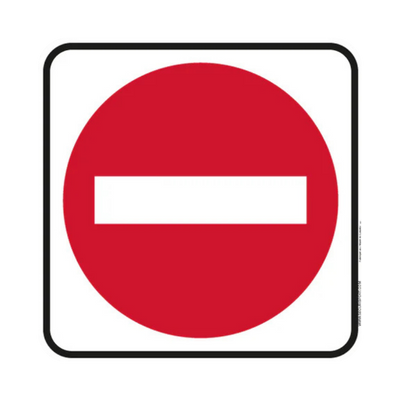
|
Access prohibitedSome trails may be closed at any time for safety or operational reasons — like fallen trees, damaged sections, special events, or maintenance work. These closures help keep everyone safe. Riding a closed trail goes against our Code of Conduct and could result in losing your riding privileges. |
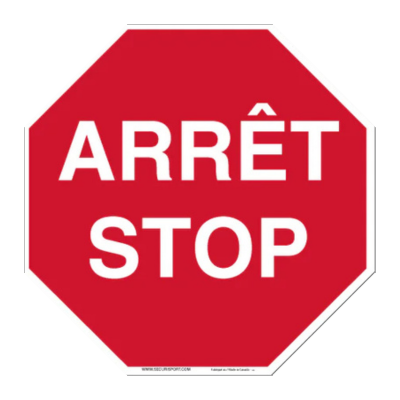
|
StopThis sign means you must come to a complete stop before continuing. |
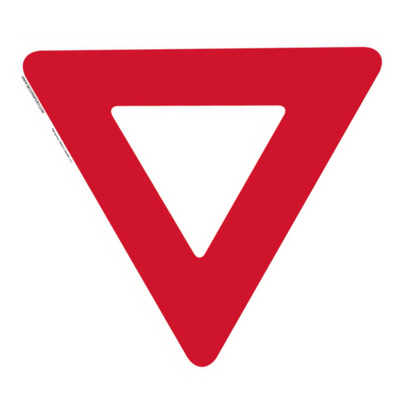
|
YieldThis sign marks the junction of multiple trails. When you see a “Yield” sign, always make sure the way is clear before entering, and give priority to riders coming on the trail you're joining or uphill when on two-way traffic trails. Ignoring this rule can cause an accident for which you could be held responsible. |
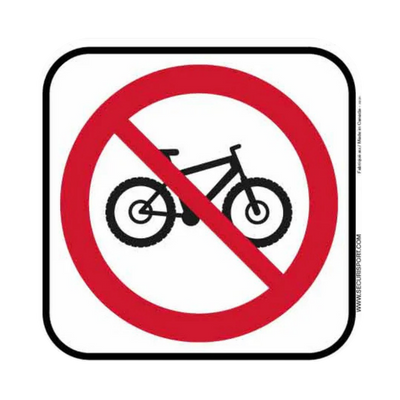
|
No bikesThis sign means mountain biking is not allowed on this road or trail. Please respect this rule to keep everyone safe and help protect the area. |
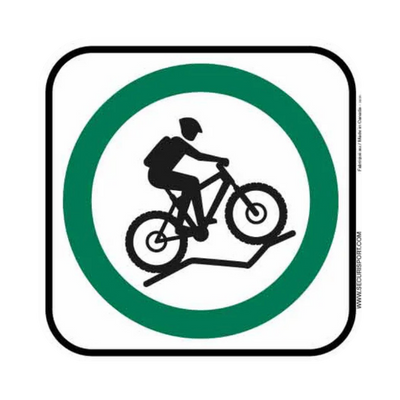
|
Mountain bike trailThis sign means the trail is designated for mountain biking. Ride responsibly and respect other riders, the environment, and the rules. |
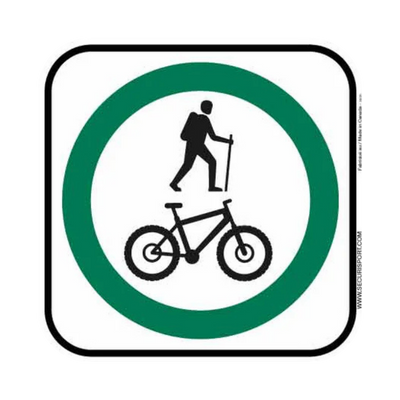
|
Shared trail – bikes & hikersThis trail is open to both mountain bikers and hikers. All users should be respectful and courteous to ensure everyone can enjoy a safe experience. |
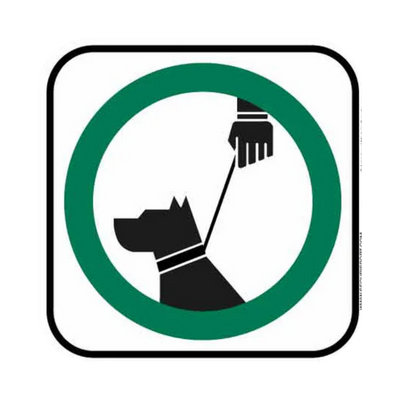
|
Dogs on leashThis sign means dogs must be kept on a leash at all times and are only allowed on hiking trails. For safety reasons, dogs are not permitted on mountain bike trails. |
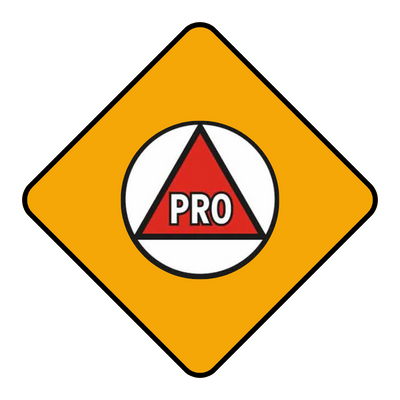
|
Caution: PRO LINEThis trail or section is rated PRO LINE and is reserved for very experienced riders only. |
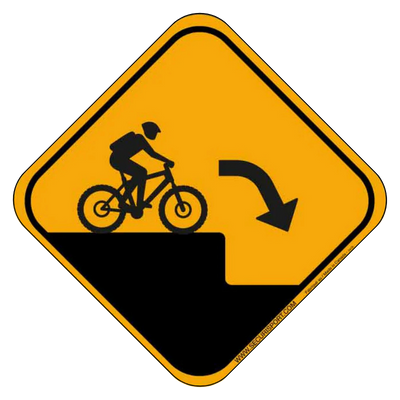
|
DropThis sign marks a feature you need to clear with enough speed so both wheels leave the ground, landing on flat or sloped terrain. |
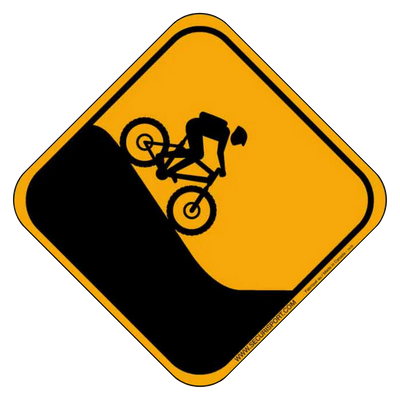
|
Steep slopeThis sign warns of an upcoming section that’s steeper than the rest of the trail. The slope may consist of packed dirt, wooden structures, or natural rock slabs. |
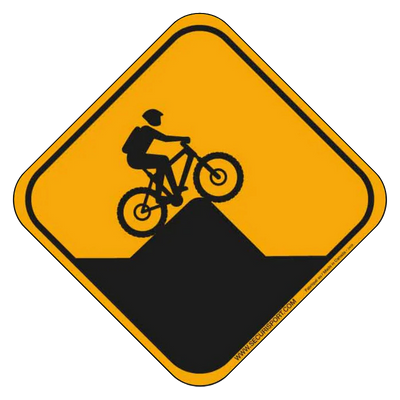
|
PyramidThis sign indicates an upcoming pyramid-shaped feature—a small uphill followed by a small downhill. |
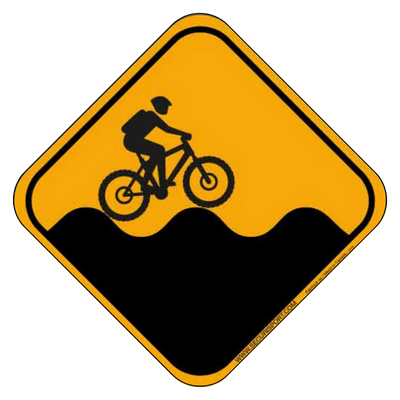
|
BumpsThis sign warns of an upcoming section with a series of small, built-up bumps. |

|
Narrow passageThis sign warns that the upcoming section is narrower than the current trail. Slow down and stay in control, especially in technical or obstacle-lined areas. |
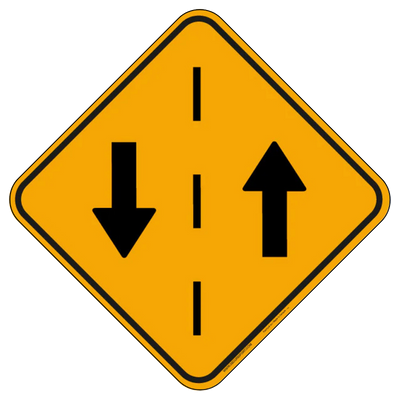
|
Two-way trafficThis sign informs riders that the trail is used in both directions. Stay alert and be ready to encounter other users coming the opposite way. |
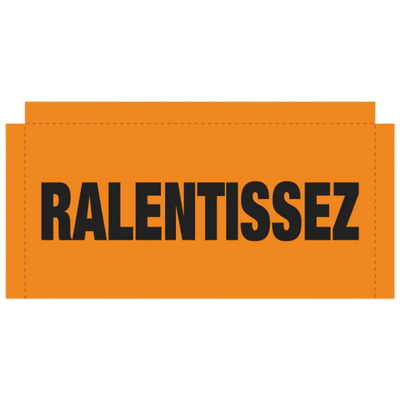
|
Slow down“Slow Down” signs mark areas where you need to reduce your speed. These zones are often at trail intersections or spots where going fast increases the risk of injury or collisions. Not following these rules can lead to suspension of your lift privileges and revocation of your pass.. |
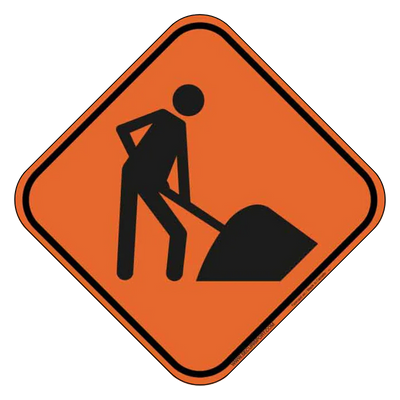
|
Work zoneThis sign indicates trail work ahead. It’s usually placed at least 15 meters before the work area. |
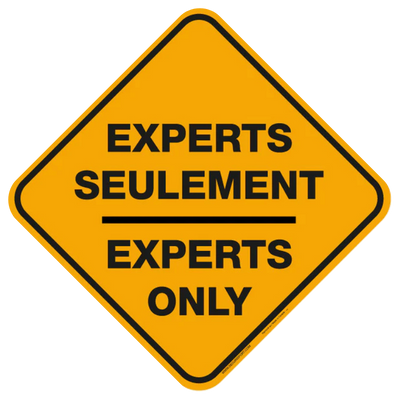
|
Experts onlyThis trail is for very experienced riders only. This sign is often added under the Difficult or Very Difficult levels to emphasize the need for the right technical skills before riding. |
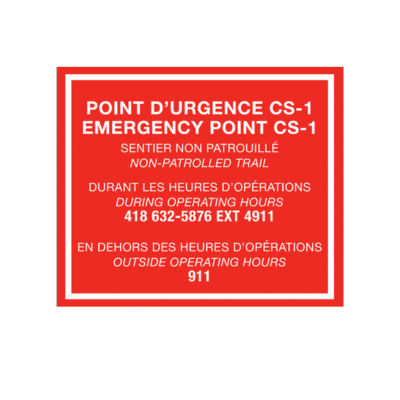
|
Emergency pointThis sign shows the location of emergency points on unpatrolled trails. In case of an incident, head to the nearest point to help emergency responders find you quickly. |
General Safety
Trail difficulty levels
For your first visit, we recommend all mountain bikers—regardless of experience—start on the easiest trails. This helps you get a good sense of the resort’s specific difficulty levels before trying more technical trails.
| 🟢 | Easy |
|
Beginner riders with limited technical skills |
| 🟦 | Intermediate |
|
Riders with basic technical skills |
| ◆ | Difficult |
|
Riders with advanced technical skills |
| ◆◆ | Very Difficult |
|
Riders with highly advanced technical skills, comfortable taking risks |
| 🔺 | Pro Line |
|
Expert riders with well above-average technical skills, very comfortable taking risks |
Ride smart
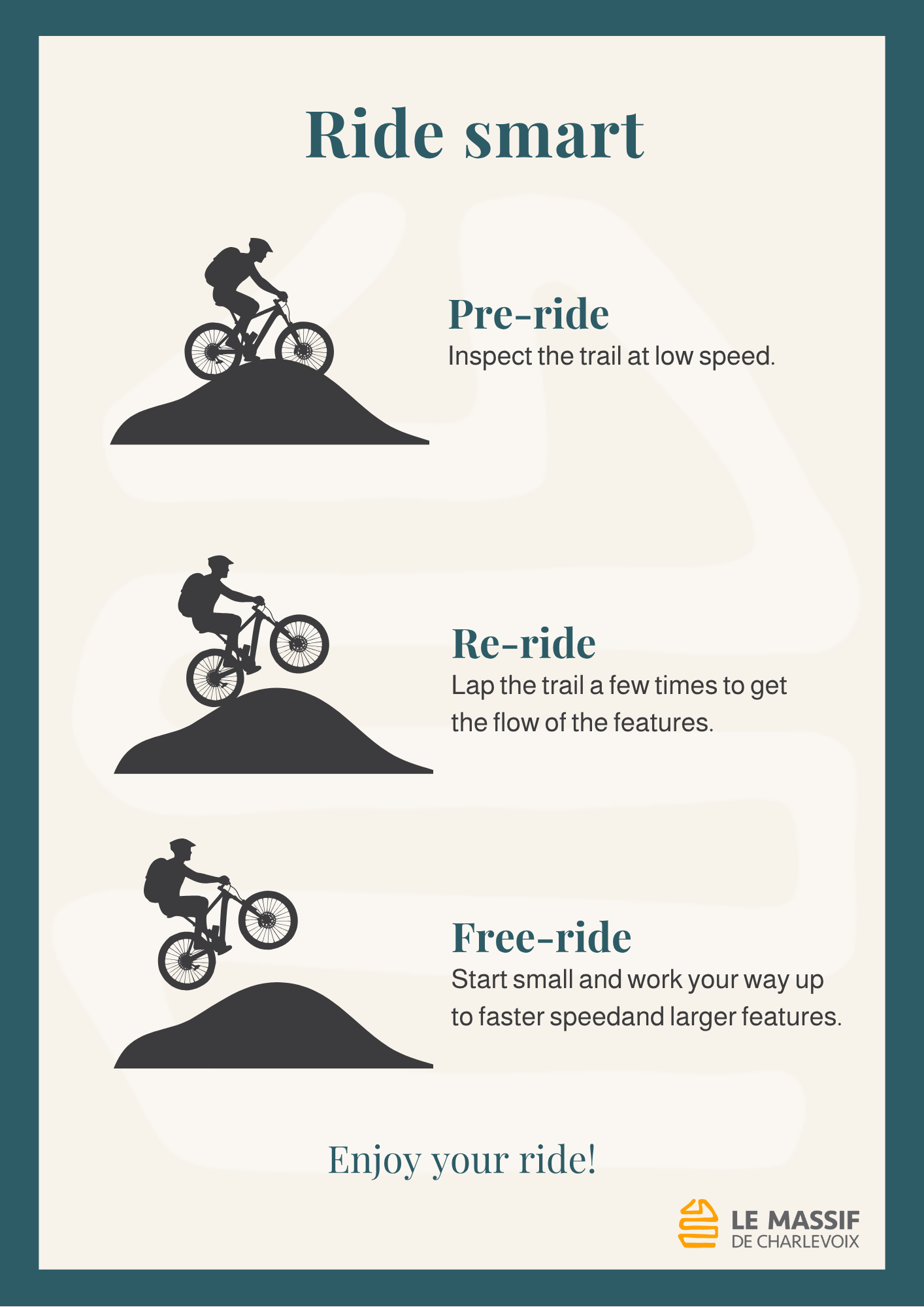
Signage and barriers
All poles, flags, barriers, protective padding, signs, and other markings on the mountain are there to alert you to obstacles or potentially hazardous areas. However, these measures do not guarantee your safety or prevent injury. According to the Alpine Responsibility Code, it is your responsibility to remain vigilant and avoid all hazards, even those that are marked.
Drone use
Recreational drone use is strictly prohibited at Le Massif de Charlevoix due to safety concerns, privacy risks, and its impact on the guest experience. Any violation of this rule may result in a warning or expulsion from the area. Commercial drone operations are permitted only with prior written authorization from Le Massif de Charlevoix.
Dogs on leash
Dogs are only allowed on hiking trails and must be kept on a leash at all times. For safety reasons, they are not permitted on mountain biking trails.
Equipment and preparation
Helmet use
At Le Massif, wearing a helmet is mandatory on all mountain biking trails. This measure is in place to ensure the safety of all riders, regardless of their skill level or the type of trail they choose. While helmets cannot prevent all types of injuries, they remain a crucial piece of protective gear in the event of a fall or collision. We encourage all riders to learn about the benefits and limitations of helmet use.
Bike weight and size
For safety reasons and to protect gondolas, bike racks, and trails, your bike (electric or not) must meet the following criteria:
- Maximum weight: 55 lbs (25 kg).
- Maximum tire width: under 5 inches.
If in doubt, your bike may be weighed at loading.
Allowed equipment
- Enduro bike.
- Cross-country bike.
- Full suspension or hardtail bike.
- Downhill bike (not recommended, since pedalling is required in some sections).
Prohibited equipment
- Bikes without brakes.
- Bikes with only one brake.
- Any bike with a child seat is prohibited on downhill trails (allowed on adventure trails).
- Any type of trailer on downhill trails (for adventure trails, we rent Thule Chariot-style bike trailers.)
- Any urban or hybrid bike for kids.
- Tandem bikes of any kind.
- Scooters.
- Tricycles.
- Training wheels.
- The bungee system should only be used for the Bus jaune and Traversier uphill rides. Never on downhill sections.
Pre-ride checklist
Before hitting the trail, make sure you have the following items with you:
- Spare inner tube – in case of a flat tire.
- Multi-tool – for minor adjustments or repairs.
- Cell phone – to stay reachable or contact emergency services if needed.
- Mini pump – to inflate a tire anytime.
- Tire levers – to help remove and replace the inner tube.
Get ready for the mountain
- Sunscreen, sunglasses, and helmet or hat—even on cloudy days.
- Lightweight clothing, but suited for changing weather.
- Drink regularly to stay hydrated.
Mountain Behavior
Speed and safety tips to avoid collisions
Along with the Mountain Code of Conduct, here are three good habits to help keep you and others safe on the trails:
- Anticipate
Always maintain control of your speed and line. Be prepared to slow down or change direction to avoid obstacles, other riders, or terrain changes—whether on a built trail or in wooded areas. - Stay Alert
Always keep an eye on your surroundings: other riders, intersections, turns, trail conditions, and visibility. Staying focused helps you react quickly and avoid dangerous situations. - Adjust Your Ride
Slow down in areas with limited visibility and maintain a safe distance from other riders. When riding a trail for the first time, take your time to explore it carefully and identify technical sections or obstacles.
By keeping these three principles in mind every ride, you help create a safer and more enjoyable environment for everyone.
Access prohibited outside operating hours
Even when the lifts are closed, our teams continue working on the mountain day and night. Being on the trails outside operating hours puts your safety and our staff at risk.
Unpredictable Conditions
Visibility is often reduced after hours, and parts of the terrain may be obscured by the landscape, equipment, or poor lighting. You might not see maintenance vehicles approaching, and our teams may not spot you in time.
No Emergency Services Available
If an accident or injury occurs, no patrol members are on duty to assist. You could be left stranded without help for an extended period, increasing the risk of serious complications.
Hazards from Operating Equipment
After hours, heavy vehicles (trucks, cranes, utility ATVs) operate on the mountain. Their unexpected presence and low visibility significantly increase the risk of collisions. Operators do not expect riders, so any encounter could have serious consequences.
Mountain Lifts
General rules
- If it’s your first time using a lift, take a moment to watch how it works or ask a staff member for help.
- Be courteous to other users.
- Slow down as you approach the loading area.
- Keep your RFID card is on you, preferably in the left pocket of your jacket, for quick scanning.
- Only board and exit lifts at designated spots.
- Follow all posted signs and staff instructions.
- To ensure smooth loading, gather as a group before reaching the platform.
- Remove all headphones before entering loading or unloading zones.
- After leaving the seat, clear the unloading area promptly.
Children and supervision
- If you're with a young child, assist them getting on and off the lift. Never leave them unattended—you are responsible for their safety.
- Ensure the child is seated properly and securely at the back of the seat.
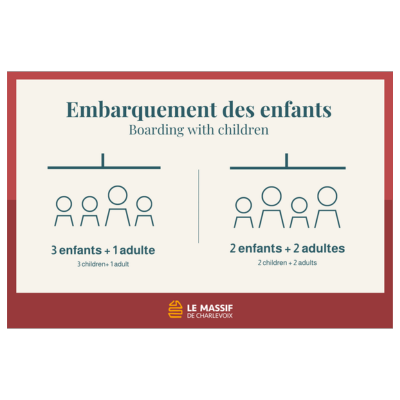
|
Boarding with childrenTo keep young riders safe, make sure children are seated between adults when boarding. This allows for constant supervision and ensures the safety bar can be handled securely. |

|
Minimum heigh requirement: 135 cm tall to ride the chairlift aloneChildren under 135 cm may have difficulty operating the safety bar by themselves. To ensure their safety, they must be accompanied by an adult when boarding. This helps provide proper supervision and safe use of the lift. |
Safety and behavior
- Before boarding a chairlift, remove your backpack or any bag worn on your shoulders.
- During loading and unloading, lift your poles and remove the straps.
- If you fall while unloading, keep your head down and move quickly out of the way.
- Do not swing, jump, or behave recklessly on the lift. If riding alone, sit in the center of the seat.
- Always lower the safety bar as soon as you're seated.
- Before unloading, check that your clothing or accessories are not caught.
- In the event of a temporary stop or rollback, never attempt to jump off.
Procedure for loading your bike
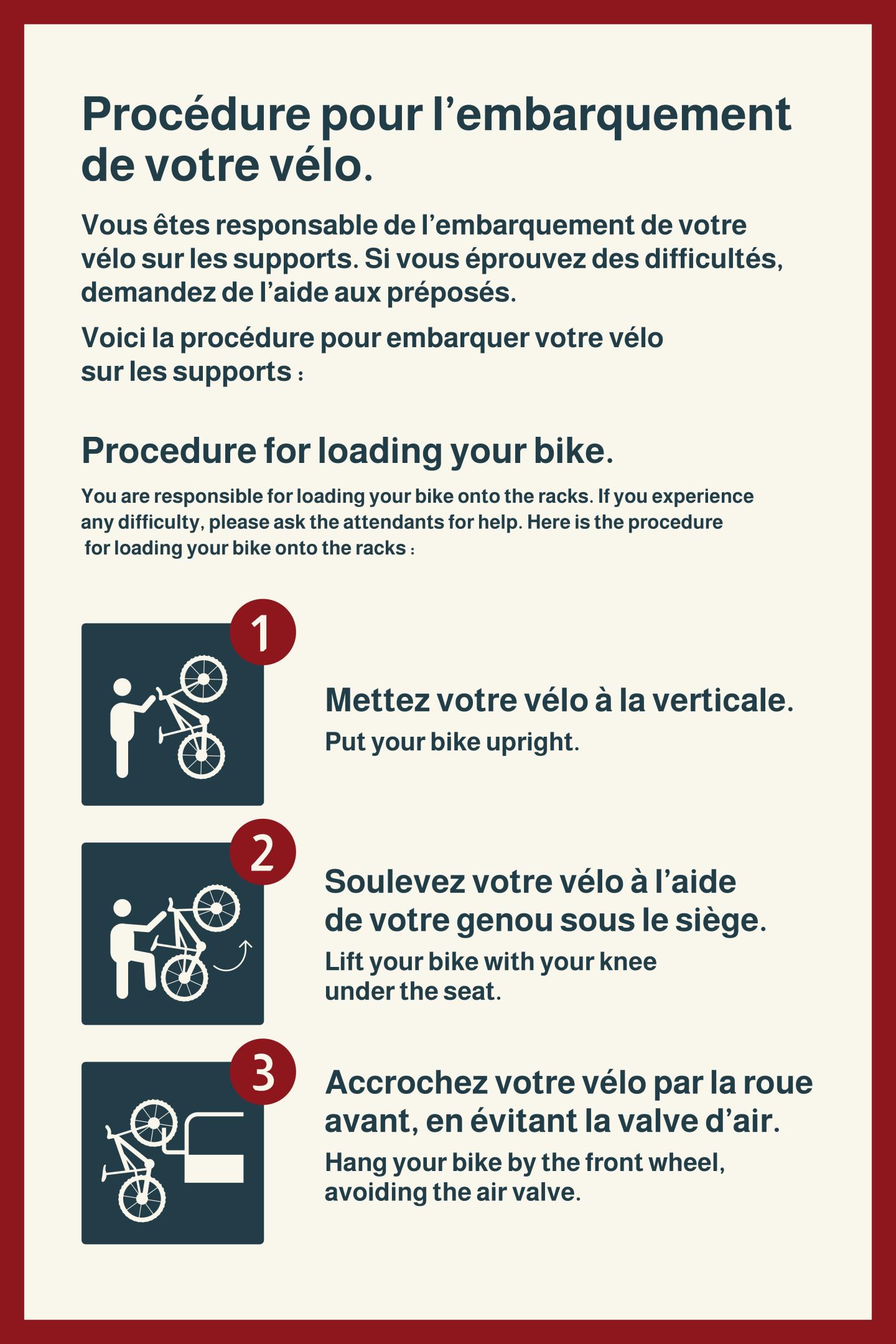
In Case of an Accident
What to do in case of a mountain accident
If you are involved in a collision or incident on the trails, both the law and the Mountain Code of Conduct require you to stop, provide assistance, and give your name and contact information. It is also essential to report the accident to the patrol.
How to Report an Accident
In an emergency situation on the mountain, contact the patrol by calling the emergency number listed on the trail map: 418-632-5876, extension 4911. We recommend saving this number in your phone before you head out.
If you are unable to call yourself, ask another rider to go to the nearest lift station and alert an attendant, who can then contact the patrol.
When communicating with the patrol, try to provide:
- The exact location of the incident (e.g., trail name, lift tower number, GPS coordinates if available).
- A description of the accident and any present hazards.
- The number of injured persons and, if possible, the nature of the injuries (e.g., loss of consciousness, head or spinal injuries).
On-Site Priorities
Once the alert has been given, follow these steps:
- Ensure the safety of everyone – yourself, the scene, then the injured person.
- Stabilize the head and neck if necessary.
- Check for breathing.
- Control any bleeding.
General terms and conditions
Please review the rules governing access and the services offered.
Acknowledgment and Acceptance of Risks
Learn about the risks associated with mountain activities and your responsibilities.
Read the risk information